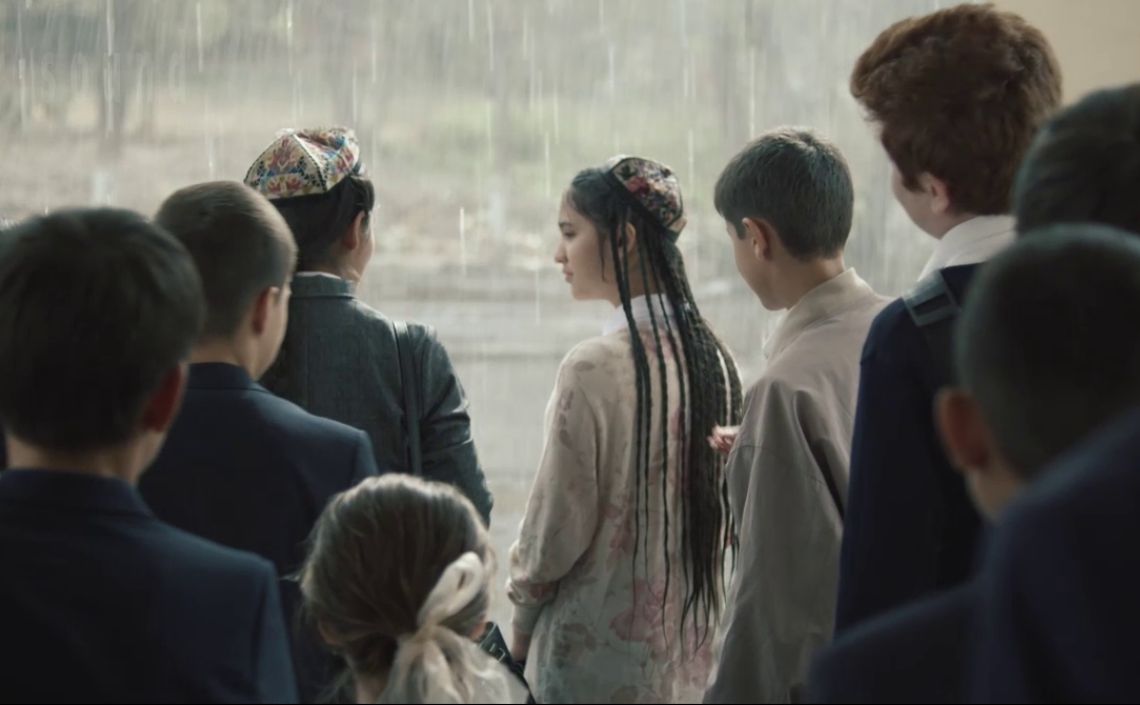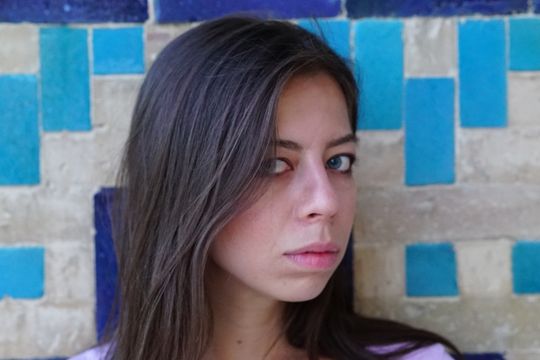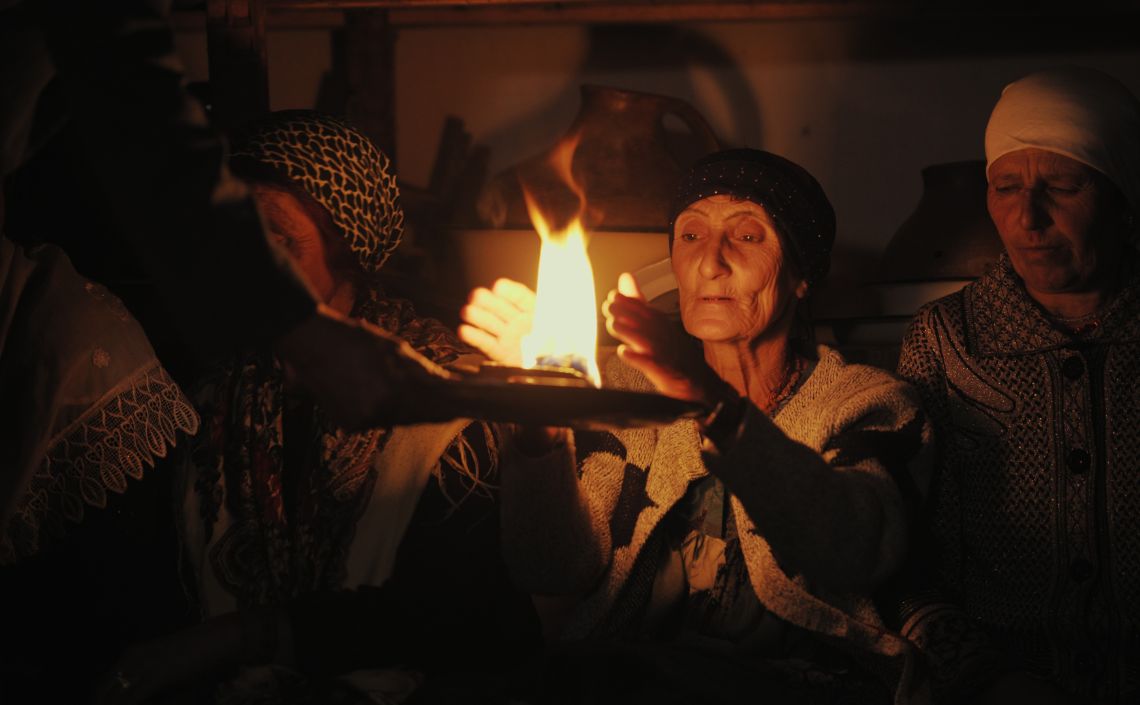Anisa Sabiri takes us to Tajikistan’s remote areas, where - as she says - "rhythm is the language of time”. Traditional practices dating back to Zoroastrian times have been kept alive, evolving sometimes naturally and sometimes in response to the ever-changing demands of Soviet, Islamic and capitalist influence. Music is an organic part of life for these communities, deeply embedded in their everyday activities. The film depicts music performed at funerals, fire ceremonies and weddings, with male and female singers alike. Sabiri arrives as a non-intrusive guest, capturing the scenes with care, aided by her experience as a tour guide in the Pamir mountains. We caught up with the now London-based filmmaker to find out more.
- 23-27 OCT 2024
- Manchester, UK
RHYTHM IS THE LANGUAGE OF TIME
Interview with Anisa Sabiri
09 December 2022 by Lucia Udvardyova
You have worked as a tour guide in the Pamir mountains, as well as being a cultural activist and a photographer. Your photographs of Tajikistan, in particular, probably paved the way to film-making, too?
I never truly considered myself a photographer or even a filmmaker - it has always been a challenge to put my desires for storytelling in a certain box. Storytelling, that’s what I’d call it, or a conversation with reality through a medium. And then the artistic interest comes out through that lens - in my case, it was a combination of passionate interest to deliver the findings about my culture. I think that at this very recent stage of my life, film just turned out as the most powerful way of talking about my country and topics I'm interested in, on a bigger scale. And it naturally came about from the things I’ve done in the past. But I'm still developing my language in this craft, and learning a lot.
Your previous film, The Crying of Tanbur, was a short drama set in the post-Soviet era Tajikistan as it was descending into civil war. Where did the inspiration for Rhythms of Lost Time come from?
The inspiration for both has come from the same source - ritual music. Although I share a city background, I’ve always been curious about my roots, and I think that is what made me so attracted to the countryside. When I heard the story of tanbur - a string music instrument used in ritual music to help the soul of the deceased to go through the pathway of the afterlife, and also to heal the pain of the relatives, that moved me so much. And when I found out about it, I thought that our land needs a lot of that music - to heal the pain of the civil war (1992-1997), and all the post-war traumas that are still present. That’s why Crying of Tanbur starts with the protagonist Khafez hearing nolai tanbur (the cry), soon before he finds out about his father’s death. And then I started dreaming about making a film exploring this incredible instrument, the philosophy behind it and similar instruments.
One of the important premises of Rhythms of Lost Time is time and the rhythm of life, which is beautifully slow and mellow. "Time itself echoes in this ancient poetry." What importance do time and rhythm have in your film?
I believe that time itself wouldn’t exist without human beings. We have invented time as a form of guidance, and that is pretty much being reflected through music and language. And yet, rhythm is the language of time - and that’s what I find very interesting about ancient music - the capsulated time that has survived throughout thousands of years. I think that’s invaluable as a case of study and perception, and it can teach us a lot about something that we have lost - not only in a sad way.
There are several aspects to the film, including the influence of religion, political systems, imperialism, gender roles (men and women are mostly separated when portrayed during their communal activities and signing). Could you speak about these?
Each culture has a great ability to encode layers of history of peoples’ lives, and Tajik culture is a good example - current traditions from metaphysics to a complex colonial and post-colonial history of Tajikistan, and I find it amazing. To me, this complexity seemed very important to be reflected in this particular film, as some sort of a starting point - in a way, to take responsibility for a narrative-driven documentary that would let me not return to this subject anymore… So, the film Rhythms of Lost Time is not the end of the project. We have documented more than 30 hours of unique footage - so there is a lot more I am considering using in future projects. I'm now thinking of making a less narrative adaptation, and releasing the music recordings. But this was an ambition from the very beginning - to let the footage live through different forms of media, and so to promote the Tajik culture. And I'm very grateful to our financiers - The German Embassy in Tajikistan, and the Bactria Cultural Centre for being co-minders in that.
"Someone said that traditions are like a thread of life carried through time; a connection with our ancestors; a kind of code for our communication with past and future generations." Is a quote from your film. How do you view the influence of globalisation on these remote communities?
Just as different parts of the human body, societies have always been influencing each other in the most incredible way. Places we find remote today, have been on pathways of major trade routes, or affected by migration. This is how it has been in Tajikistan - on a tiny territory 93 percent covered with mountains; you can find so much cultural diversity - because people from different places of the region have been finding their shelter in the mountains, running out of prosecution, or conquerors, or due to their spiritual search. So it would probably be incorrect of me to say that there was no influence of globalisation there before - it just had a different scale and form; and I think, now, all the mountain communities in the world share this pattern - being some DNA of different layers of the local history.
Now there are other patterns - migration to Russia, technologies, climate change, economic crises and political challenges. People in the mountains are very sensitive to all these, and much less protected than everybody else - including the danger of being exoticised, classified and put into ‘boxes’ that I find very threatening.
I think it is very important, when we come to those remote areas with respect to people who live there, without being trapped or representing them or speaking about their needs, or telling them who they are. I can see that nowadays it happens a lot, unfortunately.
The film is portraying communities in a very close and intimate way, and I assume a lot of trust was given by the community to the film team, and there is then the responsibility that comes with it for the filmmaker to select the parts to be shot, as well as the general message that the film conveys about the community.
In Tajikistan, everybody, even strangers, are welcomed to homes and most intimate events, based on the idea that life should be shared with a community, and that process is healing. But of course, there are sacred rituals that aren’t supposed to be seen by outsiders - but mainly due to political or religious issues. I suppose my background of being a tour guide contributed to building trust. But also, this worry of traditions being endangered felt important on both sides.
Midway through the film, the British musician Leo Abrahams enters the scene, who is interested in Tajik traditional music. He is present throughout the film and visits the community. What role did he have in the film?
Leo is one of the characters trying to find a religious music called maddoh - sometimes we see him meeting locals, and exploring the country. The idea that someone who has worked with Brian Eno fell in love with Tajik music made our team very excited, although Leo himself wasn’t comfortable with the idea of being featured in the film - he told me it is unnecessary. I now can see the duality of that decision we’ve made. But people in Tajikistan enjoyed Leo’s presence in the film.
There is a notion of musicianship versus music being a part of everyday life, in particular, of the various rituals (weddings, bereavement, etc - one could say of life and death) and not necessarily only for those who are musicians per se. How do you view the role of music in the lives of these communities?
Yes, traditional Tajik culture music is not considered a thing in itself. Like any other art, it has always had its practical reasons - whether to greet a child’s arrival, welcome a bride in a groom’s house, or support a family in time of pain. And yet, music can be masterfully performed by farmers who have spent all their day working in the field… So it is rather a way of celebrating life, in all its complexity and beauty, even in most dark times. And I think, with all the anxiety and pressures we are facing in the modern world, this is nice to learn - to survive as a humanity, especially in the times of an upcoming climate disaster.
You've also organised a workshop for up-and-coming filmmakers from Central Asia. What were your impressions of it, and of the emerging talent from the region?
I have started the Dushanbe-based independent cinema residency called ‘My Vision’ that produced seven films and supported public screenings and talks about films. It was exciting because the project has demonstrated a huge demand for the support of film-making initiatives. And it was nice to see too, that there can be a very warm audience response to local stories that are honest and reflect themes true to the Tajik society. At that time nobody would think that local Tajik films would gather any audience, and they did.
Unfortunately, we had to freeze the project because I moved to London. But I keep dreaming about launching a Central Asian art school focused on providing equal opportunities for talent; and I know I will do it one day.
What are you currently occupied with creatively?
I'm working on several projects, including my first feature Lola - a female-driven drama set in pre-war Tajikistan, focused on a war widow, who struggles to find her identity in a country that is falling apart. And I'm also developing Generation - a documentary that centres on the people who lived through Soviet perestroika, exploring and examining their nostalgia for Soviet times - the project was selected for Berlinale Toolbox, so I'm very excited about bringing it to life. Apart from that, I'm involved in several exciting projects - in London-based The Garden Cinema Films, and a couple of documentaries focused on post-colonialism.






